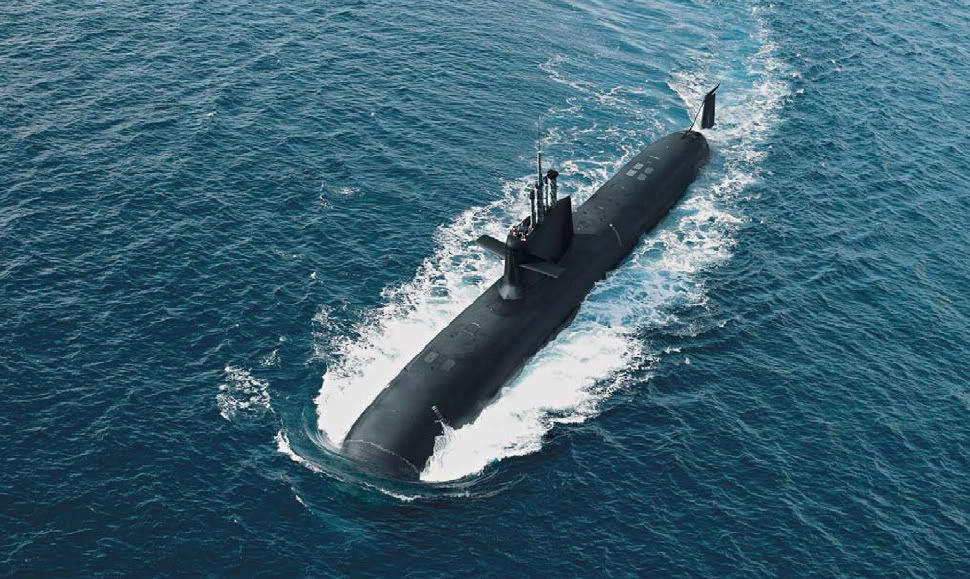
The stage is now being set for an even bigger project—this one worth over Rs 50,000 crore for six new-generation submarines for the Indian Navy.
With the Rs 18,798-crore project to construct six French Scorpene killer submarines at Mazagon Docks in Mumbai finally gaining momentum, Indian Navy is now on the look out for six next-generation submarines in a project which was worth over Rs 30,000 crore back in 2008 and now the amount has increased to 50,000 crore
The Defence Acquisitions Council (DAC), chaired by defence minister A K Antony, has finally decided that three of the six submarines will be constructed at Mazagon Docks (MDL) in Mumbai and one at Hindustan Shipyard Ltd (HSL) in Visakhapatnam, with the help of a foreign collaborator.
"The other two submarines will either be imported from the foreign vendor directly or constructed at a private shipyard in India. Fresh estimates show each of these six diesel-electric submarines will cost almost Rs 8,500 crore," a source said.
Under the programme—called Project-75 India (P-75I)—apart from stealth, land-attack capability and the ability to incorporate futuristic technologies, all the six new submarines will be equipped with air-independent propulsion (AIP) systems to boost their operational capabilities.
Conventional diesel-electric submarines have to surface every few days to get oxygen to recharge their batteries. With AIP systems, they can stay submerged for much longer periods, narrowing the gap with nuclear-powered submarines which can operate underwater for virtually unlimited periods.
The selection of the foreign collaborator for P-75I will, of course, take time because a RFP (request for proposal) will first have to be issued to submarine manufacturers like Rosoboronexport (Russian), DCNS/Armaris (French), HDW (German) and Navantia (Spain). Shortlisting and detailed technical and commercial negotiations will follow, before the actual contract can be inked.
Russian will be pitching for their latest Amur 1650 which is very silent and an advanced version of kilo-class, The French will be pitching their latest Andrasta class submarine that is a smaller version and based on Scorpene class, Italians will be pitching for S-80 Submarine and the German will be pitching for U 214 which is an advance version of U 212
Navy has reasons to be worried. By 2015 or so, it will be left with just half of its present fleet of 15 ageing diesel-electric submarines—10 Russian Kilo-class, four German HDW and one Foxtrot. Moreover, it has been hit hard by the almost three-year delay in the ongoing Project-75 for six French Scorpene submarines at MDL, under which the vessels were to roll out one per year from 2012 onwards, with price escalation pushing the total cost beyond Rs 20,000 crore, as was first reported by TOI.
For P-75I, the second line of submarines, the navy was keen on a private domestic shipyard to tie-up with the foreign vendor since it felt MDL was already "overloaded" with orders and quick delivery schedules were "critical".
But the DAC has decided otherwise, holding that the infrastructure and capabilities acquired by MDL in the Scorpene project could not be allowed to go waste. "Let’s hope thing go smoothly now, and instead of 10 years, the navy gets its first submarine under P-75I in six to seven years," an official said.
Submarines can be game-changers in any conflict. And if they are armed with nuclear-tipped missiles, they provide the most effective strategic deterrent available around the world at this point of time. The US and Russia, after strategic arms reduction pacts, in fact, plan to retain over 60% of their nuclear weapons in the shape of SLBMs (submarine-launched ballistic missiles) fitted on nuclear-powered submarines called "boomers", or SSBNs.
Though India does not have nuclear submarines and SLBM capabilities at present to complete its "nuclear triad", it hopes to move forward by inducting the Akula-II class attack submarine K-152 Nerpa on a 10-year lease from Russia in October this year, and then the first indigenous nuclear submarine INS Arihant by early-2012.
Pakistan, incidentally, already has its first Mesma AIP-equipped submarine, PNS Hamza, the third of the French Agosta-90B submarines it has inducted since 1999. It is now looking to induct three advanced Type-214 German submarines with AIP. China, in turn, has 62 submarines, with 10 of them being nuclear-propelled.
No comments:
Post a Comment